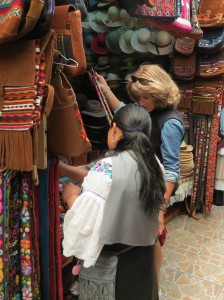Shigra shopping in Ecuador
Oh, I am so sorry. I just got back from a trip to Ecuador and now you’re going to have to hear all about it and look at my pictures and EVERYTHING! But mostly, you’re going to have to hear about shopping for shigras and how they just don’t make them like they used to – because they don’t!
Let me backtrack a bit and confess to you that I am a bit of a shigra junkie. I don’t have piles and piles of them, though I do have three very nice ones. I do love them, however, and when my husband and I decided to go to Ecuador, I knew that I would be doing some serious shigra shopping. There is something about the labor intensity of removing the fibers from an agave-like plant, dyeing them in fantastic colors, and the delecacy of weaving them all together with a blunt-ended needle to create remarkable figures and geometric patterns as the bags take shape. I feel like they’re on trend and timeless all at once. Off to Ecuador and off to market!
The first market of opportunity was Quito’s El Mercado Artesenal La Mariscal. Stalls and stalls of booths with handcrafted items from Ecuador and beyond. I saw flutes. I saw embroidered blouses. I saw handwoven belts and table runners and hair ties. I saw knitted sweaters and scarves and ponchos and mittens. I did not go away empty-handed, but I saw no shigras.
On to Otavalo, home of the largest indigenous market in all of South America. But it was Wednesday
when we arrived and though the market runs every day, THE market day is Saturday so we waited it out, hiking beautiful mountain lakes and waterfalls in the meantime. (A wonderful diversion, incidently!) We also toured a few local artesan workshops, among them Artesania El Gran Condor in Peguche, where we watched wonderful weaving demonstrations as well as how wool is carded and dyed. (See a video from the shop here: http://www.youtube.com/watch?v=PQErDubP4ho )There were piles and stacks and oodles and boodles of textiles of every Andean kind and in a small stack in a remote corner of the third floor I found three shigras. Just three! They were fine. They were nice. They were not extraordinary, but they would make good gifts to bring home so I bought them all. When we got to the market on Saturday, we saw more shigras, but more of the same. Nice enough, but not extraordinary.
Here’s what I’m talking about. These vs. THIS. Casey got her shigras for It’s Cactus when she was travelling to the Andes regularly 15-ish years ago and luckily still has a number of great ones in stock. Notice the fineness of this one; the tightness of the weave and how even it is? Notice the bold, well-formed figural and geometric patterns? That’s what you don’t see anymore. You’ll see bags that are fun, colorful, and functional, but not great. Nope, they just don’t make ’em like they used to…





![ecu8057[1]](https://blog.itscactus.com/wp-content/uploads/2012/07/ecu805711-196x300.jpg)
 That’s how mine looked, the day it was given to me. A beautiful shigra with bold geometric patterns, animals, trees, numbers, and letters in pink, red,orange, brown and black and two long fiber straps. Two days later, however, it had been altered by my dog, who decided to add a little fiber to her diet, I guess. She had a mouthful and my straps were a tattered mess. I said, “Oh no, no, no, you naughty Little Darling,” or maybe something a tiny bit stronger, and saved what I could. I retied the ends and that worked well enough for a while, but admittedly, they were a little short. Eventually I replaced them entirely with leather. This was at no small expense, but in all honesty, I think it was worth the price. The new handles nicely preserve the integrity of my shigra and I happily carry a fantastically functional and fashionable Andean textile everywhere I go. My basset hound too, is pleased with my shigra’s stylish utility and she is very glad she didn’t eat the whole thing after all.
That’s how mine looked, the day it was given to me. A beautiful shigra with bold geometric patterns, animals, trees, numbers, and letters in pink, red,orange, brown and black and two long fiber straps. Two days later, however, it had been altered by my dog, who decided to add a little fiber to her diet, I guess. She had a mouthful and my straps were a tattered mess. I said, “Oh no, no, no, you naughty Little Darling,” or maybe something a tiny bit stronger, and saved what I could. I retied the ends and that worked well enough for a while, but admittedly, they were a little short. Eventually I replaced them entirely with leather. This was at no small expense, but in all honesty, I think it was worth the price. The new handles nicely preserve the integrity of my shigra and I happily carry a fantastically functional and fashionable Andean textile everywhere I go. My basset hound too, is pleased with my shigra’s stylish utility and she is very glad she didn’t eat the whole thing after all.